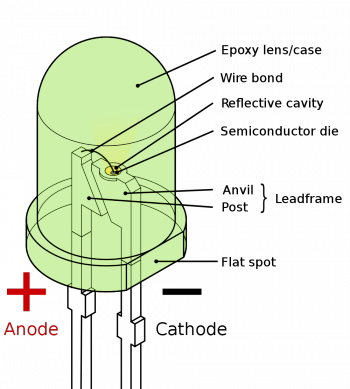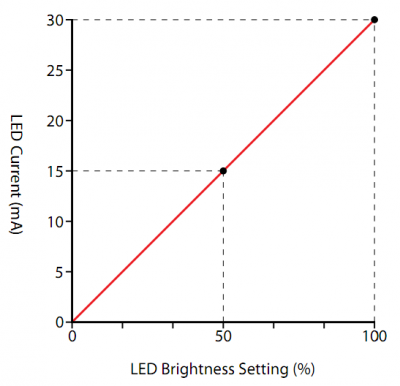LED Guide

|
Introduction
Like normal diodes, Light Emitting Diodes (LEDs) are semiconductor devices designed to conduct current in one direction only. What makes LEDs unique is their internal material makeup: when atoms in an LED release energy due to the flow of forward current, it is released in the form of photons (light). Different construction materials and various phosphor coatings are used to produce numerous colors of light.
LEDs that Phidgets sells are all operable via the digital outputs on any of our interface kits. However Phidgets also sells a specific LED controller since it is often desirable to control more LEDs than even the 0/16/16 can operate. It offers some unique features such as brightness control.
Principles of operation
LEDs use electroluminescence which is an optical phenomenon in which a material emits light in response to the passage of an electric current.
As in conventional diode, current flows from anode to cathode but not the opposite. Due to the material of LEDs however, when electrons pass through their energy level drops. When that happens they release energy in the form of light.
Controlling LEDs
Forward Voltage
The materials used within LEDs that cause them to emit different colors of light affect a property called its forward voltage. The forward voltage is the voltage at which current in the forward direction will flow through the device and allow the LED to convert electrical energy into light. If the voltage applied to the LED is below the forward voltage of the LED, very little current (or none) may flow, and therefore very little light will be emitted. Most standard LEDs with colors such as red, amber, orange, yellow, and green have forward voltages below 2.75 Volts, and can be used with the PhidgetLED by simply soldering them to a connector-wire and inserting the wire into any PhidgetLED board connector. The forward voltage will default to 2.75V, and the maximum current defaults to 20mA.
Supply Voltage
| The 1031 is capable of adjusting the forward voltage supplied to the LEDs with 1.7, 2.75, 3.9 and 5 volts settings allowing you to properly drive blue, white, violet, ultra violet and purple LEDs. The supply voltage will affect all LEDs. If you set the supplied voltage too high, power will be wasted and the PhidgetLED may shut down from thermal overload. If you set the supply voltage too low, your LEDs will not be driven at the requested current, and will be dim or non-functional. |
| ||||||||||||||||||||
Maximum Current and Brightness Control
|
The maximum current can be set to 20, 40, 60 or 80mA, and applies to |
Choosing Current and Voltage Settings
Make sure to choose the minimum supply voltage setting to drive the LED that requires the most voltage during operation. Any extra voltage not required by the LED will be converted to heat by the 1031. For example, a Blue LED being driven at 20mA, 3.9V Supply, that requires 3.7 volts will cause (3.9V-3.7V + 0.4V) * 0.02A = 12 milliwatts of heat to be produced on the 1031. If this example instead uses a high power, 1.5V infrared LED at 80mA, this will create (3.9V-1.5V+0.4V)*0.08 Amps = 224 milliwatts of heat. See the Heat Dissipation and Thermal Protection section later on in this manual for more information about this issue.
Multiplexed LEDs
In an effort to reduce electrical noise in the system the 1031 does not use multiplexing. All 64 anodes are connected to the same power supply and the cathode of each LED connection is attached to an individual constant current sink. Also, the LEDs are not controlled by PWM - they are driven at a constant current.
Other Uses for the 1031
The 1031 PhidgetLED 64 is not limited to Light Emitting Diodes. It can be used to control relays, solenoids and even very small motors. The PhidgetLED can also be used to drive opto-isolators and MOSFET SSRs. A diode integrated into the 1031 on each cathode will clamp inductive surges to the anode supply voltage.
Power Requirements and Power Supply Selection
The power supply that is included with the 1031 is rated at 12V and 2A (max). If your application requires more power, a larger power supply may be necessary. The on-board voltage regulator is able to supply up to 6A for each LED supply voltage setting, as long as the power supply is able to provide enough voltage and current to the regulator. Assume an efficiency of 80% for the on-board voltage regulator when determining if a different power supply is required.
Heat Dissipation and Thermal Protection
Projects that require a high supply voltage, or have a lot of heat being produced from over voltage settings, will have over-temperature problems. This can be mitigated somewhat by understanding how channels are grouped and how the heat is distributed around the 1031. Channels are split into four groups: (0-7,24-31), (8-23), (32-39, 56-63) and (40-55); each controlled by their own individual IC. Evenly distributing the LEDs that may produce a lot of heat across these groups will balance the load on the ICs and reduce the risk of thermal overload. When thermal overload occurs, the integrated circuit (IC) controlling the involved LEDs will disable the output of all the channels it controls. For example, if an over-temperature occurs due to channel 12, all of the channels 8 through 23 will be disabled by the IC until the temperature back within the operating range. Thermal protection is activated when the die of the IC reaches approximately 160 degrees Celsius. Once the over-temperature fault has been corrected (ie, the IC has cooled down), the output channels will be re-enabled with the same settings as before the thermal shutdown. An error message will be produced during an over-temperature.


